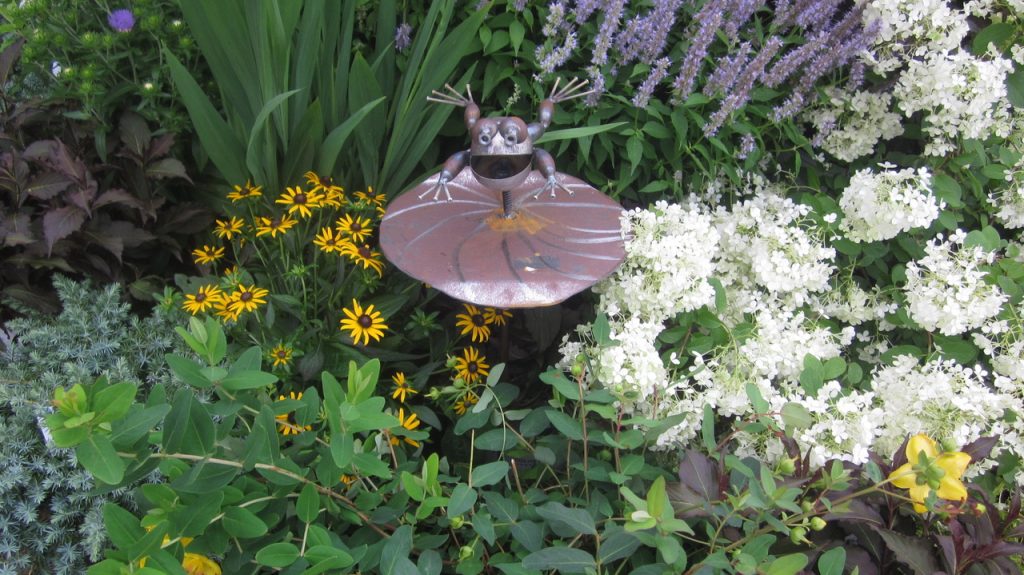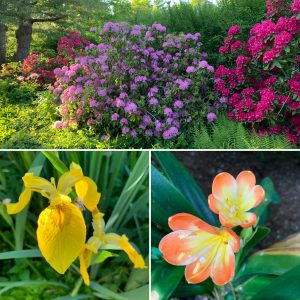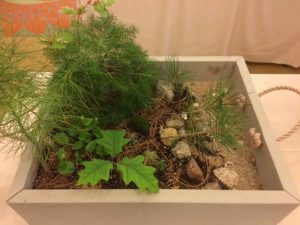From the President:
Dear Ladies:
What a wonderful year for GCBB. Great programs, flourishing Plant Sale, gratifyingly successful GCA Post Trip, culminating in a beautiful spot for a triumphant Annual Meeting with awards, good food, and friendly faces all around. Good work ladies all. A few details remain to be sorted out. Do not forget to sign up for Committee assignments. All the details are on the GCBB webpage www.gardenclubbuzzardsbay.org Coming up are floral design workshops led by Tina Read, Sally Lutz, and Carolyn Willard. You won’t want to miss July 18 Visiting Gardens in Mattapoisett. Refreshments and sweets & fruit will be provided, and in addition to bringing your own sandwich, do please bring a guest, including a spouse or potential GCBB members. It will be an interesting day with varied gardens. (Details of both events found further along in this What’s Ahead.) The weather seems to be improving as we creep into summer. Sun for a couple of days, followed by rain, but then sun again. Time to tend to our own gardens and our own agendas and relax. Thank you for a successful year. Looking forward to seeing many of you July 18.
—Ruth
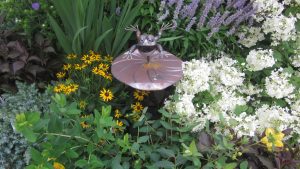
Calendar
July
Monday, July 1 —Dues are due. If you have not sent in your annual dues (and the copy of the bill itself), please send ASAP to Lisa Mellgard, 322 Smith Neck Rd., Dartmouth, MA 02748. Contact Lisa at lisa.mellgard@gmail.com. if you have questions.
Friday, July 12– 10 a.m. Flower arranging workshop on Carolyn Willard’s porch, 32 Grinnell Road, South Dartmouth. Led by Tina Read and Sally Lutz we will explore “loose” arrangements. . Details below.*
Saturday, July 13 —9:30 a.m. to 1:30 p.m. The Coastal Neighbors Network will hold its second day of garden and patio tours as a fundraiser. Many GCBB members belong to the Network. Tickets are $25 and are available on their website, coastalneghborsnetwork.org or at Alderbrook Farm on Chase Road the day of the tour.
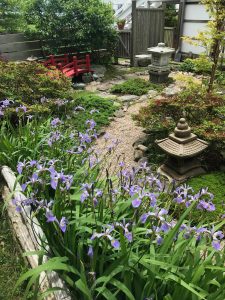 Thursday, July 18— 10:30 a.m.
Thursday, July 18— 10:30 a.m.
Summer garden tours Mattapoisett. We will tour four gardens and have a brown bag lunch.Tour begins at Ruth Ann Walega’s, at 10:30. and ends at Bluefish, Ruth Jolliffe’s garden for lunch, pictured at left.
August
Date TBA —Second flower arranging workshop explores the use of small containers, singularly or in groups.
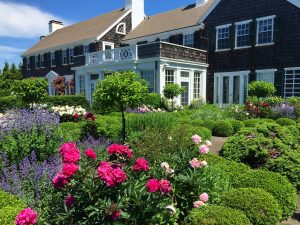
The Esposito Garden and House
Stroll. Discover. Swoon. Be inspired.
by Laura McLean
Our 2019 GCBB Visiting Gardens Day will focus on five provocative gardens: three member gardens along with two distinctive gardens within easy reach. Mark your calendars for July 18, rain or shine. The program will follow this lineup with the final destination where you can enjoy lunch (it’s bring your own with refreshments available on-site). We’ll begin at 10:30 at the home of Ruth Ann Walega, 24 North Street. The cherry tree to the right of the drive way is believed to have been transported from Japan on a whaling ship in the 1800s. This front area is the prologue to a “secret garden” further back on the property, afforded privacy from a wellestablished box hedge. Here is the heart of the garden punctuated by stone, grass and brickwork, suggestive of an old world vibe by the formal touches, the symmetrical arrangement of plants and objects as well as the inclusion of statuary. Much of the garden is firmly set with rectangular beds enclosed by hedging and the upper story marked by a lovely Kousa dogwood and rhododendrons. The beds themselves feature assorted perennials including hellebore, peonies, scilla, roses, daylilies and ground covers. 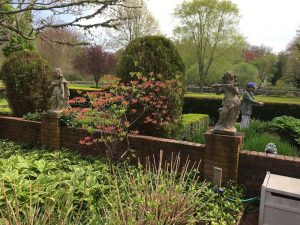 Classic lines are enhanced by lacy iron furniture that invites one to sit and enjoy the surroundings. A tuteur supporting flowering ines and a sundial add interest along with four statues of cherubs playing musical instruments set between the greenery. One gets the feeling these putting have been in concert for a solid century. Beyond the bounds of this special garden there are lawns and stone walls leading out to a brook, raspberry beds past a sprawling chestnut tree with a tire swing. The borrowed views of neighboring land lend a complementary touch to this romantic space. N
Classic lines are enhanced by lacy iron furniture that invites one to sit and enjoy the surroundings. A tuteur supporting flowering ines and a sundial add interest along with four statues of cherubs playing musical instruments set between the greenery. One gets the feeling these putting have been in concert for a solid century. Beyond the bounds of this special garden there are lawns and stone walls leading out to a brook, raspberry beds past a sprawling chestnut tree with a tire swing. The borrowed views of neighboring land lend a complementary touch to this romantic space. N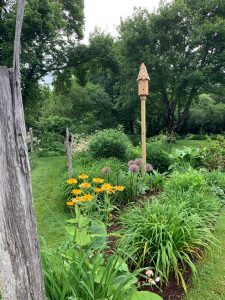 ext we will view two side by side properties at 14 & 16 Foster Street (4th left off Beacon St.). 14 Foster Street is the home of Jim Nordquist, a gifted plantsman whose garden features many unusual plants brimming from spring to the end of fall. So much of his landscape is the result of steadfast dedication. Returning from vacation a few years ago with a lovely tender mimosa sapling from a mother tree with “beautiful bright pink fiberoptic-like flowers,” he lost no time installing it in a bed of exotic plants dominated by banana trees. [Sadly the mimosa died this year although there are some new shoots growing at the base.] A trio of four-year-old red bananas serve as sentries to his garden – another out back is eight years old. They overwinter in the basement -he admits it’s “a big chore but worth the effort! They sway in the breeze and offer a nice view.” Two Pawlonia tomentosa (empress tree) started by seed, are cut back each spring, and grow upright and fast in the bed near the birch tree. A series of triangular beds feature vegetables including Globe artichokes and an heirloom rhubarb, artfully mixed with annuals. A mahogany and cedar obelisk was designed for interest and height in the herb garden – it has thunbergia growing at each leg as well as horseradish. Pots of orchids flank the shady side of the shed while on the sun-infused side, a nearby strawberry pot explodes with native cactus (opuntia humifusa) hardy in our area. Daylilies are one of the plants that extend summer bloom with seeming effortlessness. Jim uses them liberally to keep the garden pulsating with color through summer. In the far reaches of the property is a young orchard, complete with deer fencing, an area that Jim plans to expand.The hanging baskets on the porch and two iron urns one near the shed feature European style cascading balcony gernaiums, which will flourish with the summer heat.
ext we will view two side by side properties at 14 & 16 Foster Street (4th left off Beacon St.). 14 Foster Street is the home of Jim Nordquist, a gifted plantsman whose garden features many unusual plants brimming from spring to the end of fall. So much of his landscape is the result of steadfast dedication. Returning from vacation a few years ago with a lovely tender mimosa sapling from a mother tree with “beautiful bright pink fiberoptic-like flowers,” he lost no time installing it in a bed of exotic plants dominated by banana trees. [Sadly the mimosa died this year although there are some new shoots growing at the base.] A trio of four-year-old red bananas serve as sentries to his garden – another out back is eight years old. They overwinter in the basement -he admits it’s “a big chore but worth the effort! They sway in the breeze and offer a nice view.” Two Pawlonia tomentosa (empress tree) started by seed, are cut back each spring, and grow upright and fast in the bed near the birch tree. A series of triangular beds feature vegetables including Globe artichokes and an heirloom rhubarb, artfully mixed with annuals. A mahogany and cedar obelisk was designed for interest and height in the herb garden – it has thunbergia growing at each leg as well as horseradish. Pots of orchids flank the shady side of the shed while on the sun-infused side, a nearby strawberry pot explodes with native cactus (opuntia humifusa) hardy in our area. Daylilies are one of the plants that extend summer bloom with seeming effortlessness. Jim uses them liberally to keep the garden pulsating with color through summer. In the far reaches of the property is a young orchard, complete with deer fencing, an area that Jim plans to expand.The hanging baskets on the porch and two iron urns one near the shed feature European style cascading balcony gernaiums, which will flourish with the summer heat.
Laura McLean’s garden at 16 Foster Street —This garden that I’ve created and manicured for 30 years had a previous tenant or two, dating back to farmers. So as with all life, history is present.
A snowball hydrangea transplanted from my great randmother’s border, a Japanese maple that planted itself from the mother tree over the neighbor’s wall and steps that friends from long ago rebuilt all have lovely connections to the past. Among the specimens are a Seven Son’s tree (Heptacodium miconioides), a fastigiate copper beech, an Elizabeth magnolia, a weeping Alaskan cedar and a fastigiate hornbeam. I recently added to our little orchard two cherry trees ‘Romeo’ and ‘Juliet’ and in other areas: a weeping willow; 3 standard hydrangeas ‘Pinky Winky’ and a Sunlight Lace Hinoki Cypress. My borders include a woodland garden loaded in spring with English bluebells and epimedium; several raised vegetable/herb beds; the aforementioned orchard; a raspberry garden screening a defunct chicken house to perhaps be rescued at some future point; a long run-amok privet hedge; roses and perennials. The beds follow a naturalistic style and the seating within from patio, deck, gazebo, balcony all are intended to invite one to contemplate the surroundings. My husband built the glass greenhouse and the grape-covered gazebo walled with espaliered fruit trees. We are also bee-keepers – the two hives are located at the rear of the greenhouse.
[The garden is my resume, my relaxation, my raison d’etre … it is part problem-solving, meditation, adventure and vastly poetic as the English Romantic poet John Keats knew. Depending on my position, I can see it from the slug’s perspective or the bird’s, but I prefer to see myself as a butterfly, surveying its kingdom from within and without.]

At 18 Ned’s Point Road is a seaside sanctuary owned by Mike Esposito. This private seaside garden is a jewel in the crown of our tour. It surrounds a regal summer home on the harbor dating back to 1916 with rejuvenated parterre gardens suitable for a Gatsby and Daisy tryst, a tea house set in a sunken garden with a view of the sea, and plants that sustain salty surroundings. The gardens are glorious in July with roses and box looking their best along with hidden gardens within the overall boundaries, one such with recumbent cherubs keeping watch over the magnificent woodland plants.
The house was designed and built by William Y. Peters as a summer residence for his family in 1916-17. The original seven acre landscape plan was developed by Arthur A. Shurcliff (born Shurtleff), a noted collaborator ofrederick Olmstead and the Chief Landscape Architect for the restoration of Colonial Williamsburg. The house and 3½ acre property was purchased by Michael Esposito and Cynthia Redel in 2002. They restored the house and seawall, reshaped the driveway and added the freestanding garage with fenced courtyard. Adapting Shurcliff’s original plans, they recreated the entrance doorway, the walled parterre garden with central pool, replanted the terrace and built a replica Tea House in a walled garden. There are currently seven garden areas: The Shade Garden; The Chalice Garden; The Tea House Garden, The Terrace; The Parterre Garden; Foundation Plantings and The Shrub Border along Ned’s Point Road.  Best known as the landscape designer for the recreation/ restoration of Colonial Williamsburg, Shurcliff’s practice encompassed not only private gardens and landscape restorations, but also the planning of publicarks, roadways and other recreational facilities. He served as a consultant to the Boston Park Dept. for several decades and as chief landscape architect for the Metropolitan District Commission. An accomplished essayist, inventor and painter, Shurcliff’s interests in American history, traditional landscape and horticulture richly informed his professional practice. The original landscape plan (Revision April 14, 1917) can be seen on the easel in the Tea House. In keeping with the Colonial Revival style of the house and barn, the gardens were laid out symmetrically and along an axis to the water. On the east side, there was a four-section parterre garden surrounding a water pool with two staircases descending into a large, rectangular walled garden. An oasis on hot summer days for the Peters and their houseguests and a popular location for weddings and functions, pictures of these gardens as they appeared in the mid-1950’s can be seen in The Silver Gull sales booklet on the table. Facinghe water was a flat, grass terrace framed with yew and juniper. The west side was walled off for servant use as a laundry yard, delivery entrance and general use. The west side of the main lawn was planted with potatoes in 1917 which was a common means to loosen and enrich the soil prior to planting a vegetable garden. Today, only two sections of the of the original parterre garden remain as the walled garden as the original garden house and two parterre sections were removed in 1984 to construct the home next door. The new Tea House and Garden was recreated in 2016. The cupola is original as is the brass dolphin on the water fountain to the left of the Tea House. Tour the grounds at your leisure; enjoy light refreshments and view the exhibits in the solarium; and, stroll out the 225 ft. pier to view the house androunds from Mattapoisett harbor. While not on the official tour, as an added bonus, feel free to walk around the gardens at The Silver Gull Carriage House at 16 Ned’s Point Road.
Best known as the landscape designer for the recreation/ restoration of Colonial Williamsburg, Shurcliff’s practice encompassed not only private gardens and landscape restorations, but also the planning of publicarks, roadways and other recreational facilities. He served as a consultant to the Boston Park Dept. for several decades and as chief landscape architect for the Metropolitan District Commission. An accomplished essayist, inventor and painter, Shurcliff’s interests in American history, traditional landscape and horticulture richly informed his professional practice. The original landscape plan (Revision April 14, 1917) can be seen on the easel in the Tea House. In keeping with the Colonial Revival style of the house and barn, the gardens were laid out symmetrically and along an axis to the water. On the east side, there was a four-section parterre garden surrounding a water pool with two staircases descending into a large, rectangular walled garden. An oasis on hot summer days for the Peters and their houseguests and a popular location for weddings and functions, pictures of these gardens as they appeared in the mid-1950’s can be seen in The Silver Gull sales booklet on the table. Facinghe water was a flat, grass terrace framed with yew and juniper. The west side was walled off for servant use as a laundry yard, delivery entrance and general use. The west side of the main lawn was planted with potatoes in 1917 which was a common means to loosen and enrich the soil prior to planting a vegetable garden. Today, only two sections of the of the original parterre garden remain as the walled garden as the original garden house and two parterre sections were removed in 1984 to construct the home next door. The new Tea House and Garden was recreated in 2016. The cupola is original as is the brass dolphin on the water fountain to the left of the Tea House. Tour the grounds at your leisure; enjoy light refreshments and view the exhibits in the solarium; and, stroll out the 225 ft. pier to view the house androunds from Mattapoisett harbor. While not on the official tour, as an added bonus, feel free to walk around the gardens at The Silver Gull Carriage House at 16 Ned’s Point Road.
The tour finale will take us to Ruth Jolliffe’s “Bluefish” gardens, 42 Water Street, where everyone can enjoy a brown-bagged lunch.The Jolliffe garden reads like a storybook with built in surprises and sections that add character to the continuing theme of earth, sky, and water. The landscape features fruit trees, vegetable plots, recently renewed Japanese garden and rectangular water gardens that mirror the sky. All of this accentuates “Bluefish” the architecturally distinctive home built in 004. To walk the grounds is to go on an sensory adventure amidst visions born of loving plants. It is a very freeing kind of environment with interactive spaces – conjuring a little bit of Alice in Wonderland if you let your imagination go. There is a checkerboard garden, a playhouse for grandchildren, a raised swimming pool and even a place for pilates.
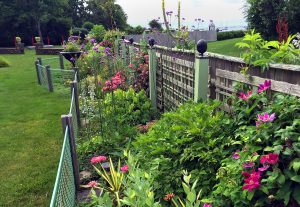
Perhaps the most unique part of the place is the AlphaBed, a 60-foot long and 4-foot wide border situated in the middle of the property – a beautiful sight from spring through fall as something is always in bloom (roses, lilies, daisies and clematis and less common bye equally impressive flora like kniphofia uvaria (hot poker lily), plumbago and oxalis springing up alongside them. The original idea hatched by Ruth would follow one rule: use plants that began with the letters of the alphabet. Part of being a successful gardener is keeping track of how your garden grows as you never really known how they will take to your soil. There have been surprises such as the Baptisia growing beyond expectations (the name “Decadence” might have foreshadowed this!) and find that the Asciepias Tuberosa was a taller variety than anticipated. Ruth surprisingly allows Felicia – technically a flower weed – to have a place here and so she has broken some of the rules.
Horticulture
The 2019 Freeman Medal winner, awarded the GCA plant of the year, is an intriguing native vine that can be used to create a lush living wall, a sheltering green roof, a thick ground cover, or an attractive privacy fence. Aristolochia macrophylla (Dutchman’s Pipe) is a deciduous vine that has been used in American gardens 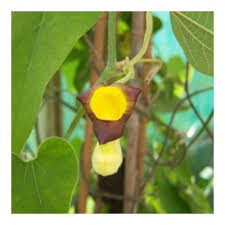 since the eighteenth century, especially to shade porches and windows from the hot summer sun. Large, heart-shaped, densely overlapping leaves 6 to 12 inches long can quickly cover an arbor or trellis with attractive, glossy, deep green foliage and create a canopy impenetrable to the rays of the sun or moderate rain. .Aristolochia macrophylla (Dutchman’s Pipe) is named for its exotic pale yellow flowers that resemble a “Dutchman’s pipe.” The flowers bloom in May and June among a swath of large, fuzzy, heart-shaped, dark green leaves. Aristolochia macrophylla, is a versatile and valuable vine that thrives in USDA zones 4 to 8, in sun to part shade, and in average to moist soil. It is deer resistant and pollution tolerant, and it has no serious insect or disease problems. It is a workhorse vine with an exotic look that would highlight a small or large native garden. Note: If we have GCBB members growing this vine, tell us what you think of it.
since the eighteenth century, especially to shade porches and windows from the hot summer sun. Large, heart-shaped, densely overlapping leaves 6 to 12 inches long can quickly cover an arbor or trellis with attractive, glossy, deep green foliage and create a canopy impenetrable to the rays of the sun or moderate rain. .Aristolochia macrophylla (Dutchman’s Pipe) is named for its exotic pale yellow flowers that resemble a “Dutchman’s pipe.” The flowers bloom in May and June among a swath of large, fuzzy, heart-shaped, dark green leaves. Aristolochia macrophylla, is a versatile and valuable vine that thrives in USDA zones 4 to 8, in sun to part shade, and in average to moist soil. It is deer resistant and pollution tolerant, and it has no serious insect or disease problems. It is a workhorse vine with an exotic look that would highlight a small or large native garden. Note: If we have GCBB members growing this vine, tell us what you think of it.
Blue Ribbons at GCA Annual Meeting
Hooray! GCBB won blue ribbons for our horticulture entries in two classes at the recent GCA Annual Meeting in Boston! For the challenge class, we propagated and grew 3 blue ribbon native plants: Pignut hickory, Boneset (eupatorium), and red oak.ur most interesting project was creating a New England Native Terrain Container Garden, which all 17 clubs in Zone 1 were required to submit. You may have seen Ruth Furman, Cathy Stone and I working on it in the greenhouse this spring. Using a “Coastal Lowland” theme, we created a scene showcasing our local terrain and typical native plants in a large cedar box measuring 22” long x 18” wide by 8” deep. The box had a sandy, rocky shore and an upland wooded area with 7+ real plants (mostly from Cathy Stone’s property) such as white pine, American beech, red spruce, etc. A fun and challenging project. The picture below doesn’t quite do it justice, but below is our blue ribbon box.
—Susan McLaren
Get Loose with Your Flower Arrangement
One of the latest trends is loose arrangements, designs which are airier and more natural that some of the older, traditional design. That will be the subject of
our first of what will be two or three Floral Workshops this summer and fall. Once again we plan to eliminate Oasis and use chicken wire to hold stems and to
rely on things in our garden or readily available. The workshop is July 12 at 10 a.m. on Carolyn Willard’s porch at 32 Grinnell Road, South Dartmouth. To reserve a spot, email Carolyn at carolynwillard@comcast.net. We have room for 6-8 people. Sally Lutz suggests bringing a container (with a foot or urn type if you have it), a frog or two (we will supply the green chicken wire if you do not have it), local flowers, branches or vines, from your garden or a friend’s. We will email a final list of what you need before the 12th.
Awards at the GCBB Annual Meeting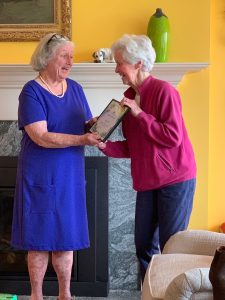
- The Awards Committee presented the following awards at the Annual meeting at Susan Sargent’s house in June.
- Medal of Merit to Ruth Furman
- Club Appreciation Award to Ellen Christie
- Horticulture Award to Happy Webb for her work with Boxwoods.
- Civic Improvement Award to Nan Sinton
- Floral Design Achievement Award to Sally Lutz
- GCBB 35 Years of Service to Joan Bullard
- Conservation Commendation to the Lloyd Center
- The Barbara Warburton Certificate of Remembrance Award to the family of Greer McBratney, one of our honorary members.
- Busy Bee Award to Holly McDonough
- Dirty Hands Work Crew to Plant Sale Chairs Cheryl Gamsby and Kathearker
- Dirty Work Work Crew to Nancy Watson and Ruth Ann Walega for the Assistant Treasurer and Notebook work for many years.
- Photos of the Annual Meeting, Susan’s wonderful gardens, etc. on the GCBB website, gardenclubbuzzardsbay.org
Did you know?
*** That Timmie Shapiro was an honorary chairman of the GCA Annual Meeting in Boston? She chaired the last Zone I meeting in Boston 19 years ago. Congratulations, Timmie.
***That we virtually sold out of ALL those coleus and made $1500 more than last year’s plant sale.
LAST but NOT LEAST
The GCBB Yearbook with member info, program, guidelines and bylaws, as well as committee assignments will be published this summer in time for the September meeting. Susan Mead, corresponding secretary, and Holly McDonough, webmaster and GCA club administration ask that everyone review

